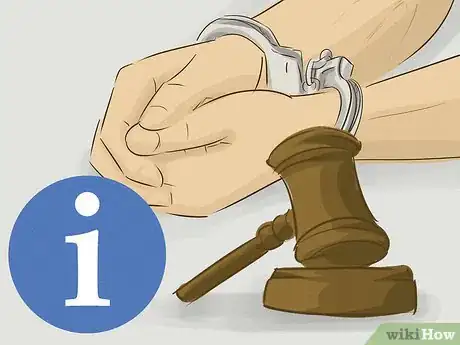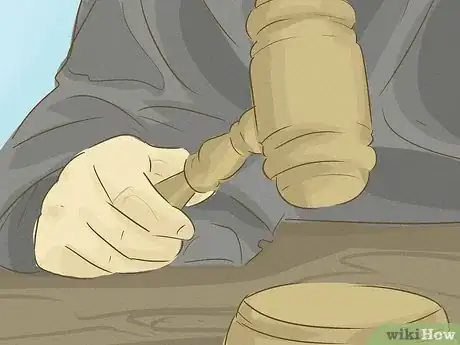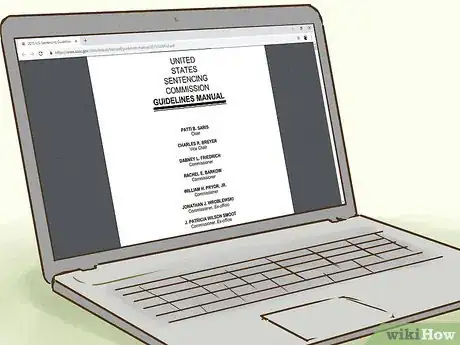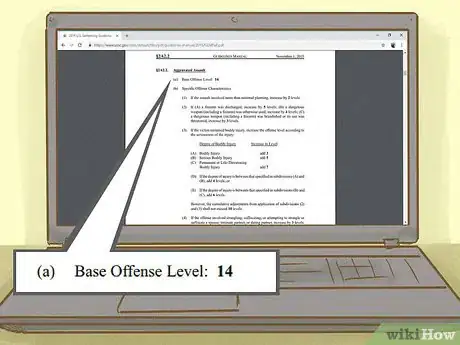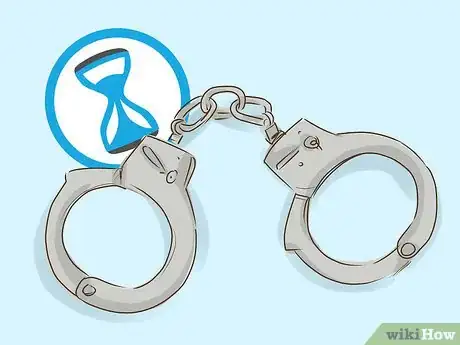This article was co-authored by Clinton M. Sandvick, JD, PhD. Clinton M. Sandvick worked as a civil litigator in California for over 7 years. He received his JD from the University of Wisconsin-Madison in 1998 and his PhD in American History from the University of Oregon in 2013.
There are 9 references cited in this article, which can be found at the bottom of the page.
This article has been viewed 86,338 times.
If you have been convicted of a crime or are considering taking a plea deal, you may want to know what your potential sentence is. For those people wondering how the length of a federal prison sentence is calculated, there is a guidebook produced by the United States Sentencing Guidelines (USSG). These figures are not entirely exact as a prison sentence is and will be based on the specific situation, however it is a good way to calculate a probable sentence.
Steps
Confirming Your Conviction
-
1Be aware of the charges against you. You won’t be sentenced on your charges, but the charges against you will impact your conviction. You must be charged to be tried and convicted, and frequently you can negotiate a conviction for a lower charge in exchange for a confession. This is called plea bargaining.[1]
-
2Attend all hearings and meetings. You are required to attend some hearings, but you should attend even those that do not require your presence so that you know what is going on. Your attorney should know the law, but there may be specific facts relevant to the hearing that only you would know.[2]Advertisement
-
3Talk with your attorney. Your attorney will do the negotiating with the prosecutor, but the decision to plead or go to trial is yours. Ask your attorney to be specific, including the statute number under which you either pled guilty or were convicted. The more information you have, the better decisions you can make.[3]
Calculating Your Sentencing Range
-
1Get the Federal Sentencing Guidelines Manual. It's free from the Government run US Sentencing Commission and can be downloaded online. This manual will walk you through the steps and is the same manual the probation officer will use when preparing the pre-sentencing investigation report.[4]
-
2Look up your "Crime Group" in Chapter 2. Your crime group is simply another term for the offense that you were convicted of. Go to the page where your offense is listed. This page will list the "Base Offense Levels" and "Specific Offense Characteristics". You will use this information to calculate your “Base Point Number”.[5]
- For example, if you were convicted of aggravated assault, you will find that offense in Chapter 2. When you find it, it will give you a base offense number. The base number is followed by specific factual circumstances that require you to lower or raise your base number by certain amounts.
- If you were convicted of kidnapping, you can find that offense in Chapter 2. The base number will be there along with a set of factual circumstances that will require you to raise your base number by specific amounts.
-
3Find your "Base Point Number". Start with your Base Crime (i.e., the crime you were convicted of) and then add points for any Specific Offense Characteristics. Work your way down the page to find your crime and various circumstances. Write these numbers down. Higher points potentially translate to longer sentences.[6]
- For example, the base number for aggravated assault is 14. If a firearm was discharged, you will add five points to the base number. If planning was involved, you will increase the base number by two.
- The base number for kidnapping is 32. If a ransom demand was made, you will increase your base number by six. If a dangerous weapon was used, you will increase your base number by two.
-
4Check for any "Point Adjustments" as listed in Chapter Three. Work your way down this list and annotate any additional levels of the crime committed. Add or subtract these “Point Adjustments” to you “Base Point Number”. These point adjustments are in a separate chapter because each factual situation may apply to multiple offenses.[7]
- For example, if you were convicted of aggravated assault and you discharged a weapon, your number is currently at 19 (14 + 5). Now, in Chapter 3, let us assume that you were found to have committed a hate crime, your current number will be increased by three. Therefore, your number is currently at 22.
- If you were convicted of kidnapping and you made a ransom demand and used a dangerous weapon, your base number is currently at 40 (32+6+2). Now, let's assume you were found to have physically restrained the victim during the kidnapping. Chapter 3 tells you that your base number will increase by two because of this added fact. Therefore, your base number is now at 42.
-
5Calculate your “Criminal History and Criminal Livelihood” points. Annotate points based on your past criminal history and amount of arrests and convictions as listed in Chapter 4. You should now have two (2) numbers: Your Base Number (including any adjustments), and your Criminal Livelihood number.[8]
- For example, if you have had two prior sentences exceeding one year and one month in prison, you will add three points for each one, which means you will have a total of six.
- If you have no criminal history and your kidnapping conviction was your first offense, you will not have a Criminal History and Criminal Livelihood point value.
-
6Use the Federal Sentencing Table to determine your length of time in prison. Go down the left side of the chart to locate your Base Number. Follow that row to the right until you see the range under your Criminal History and Criminal Livelihood number (across the top). That range is the minimum and maximum sentencing in months.[9]
- Using the aggravated assault example in previous sections, your offense level is 22 and your criminal history category is III (because you have six points). Using the chart, the required sentence will be between 51 and 63 months.
- Using the kidnapping example in previous sections, your offense level is 42 and your criminal history category is I (because you have 0 points). Using the chart, the required sentence will be between 360 months to life.
Preparing for Judicial Discretion
-
1Read the pre-sentencing investigation report. This report is generally prepared by a probation officer assigned to your case. It will discuss the calculations made under the sentencing guidelines, above, as well as discuss any aggravating factors (things that might indicate the court should be harsher in sentencing) and any mitigating factors (things that might indicate the court should be less severe in sentencing). If anything in the report is inaccurate, discuss it with your attorney so s/he can talk with the probation officer to get it corrected prior to the sentencing hearing).[10]
-
2Anticipate victim impact statements. Victims and other people impacted by your crime are often allowed to testify at the sentencing hearing. Sometimes these witnesses will ask for leniency in sentencing, but victim impact statements are usually designed to induce the judge to impose a harsher sentence.[11]
-
3Exercise your rights to allocution. At sentencing, you have the right to speak to the judge about any remorse you feel about having committed the crime and why leniency should be shown for you when determining the sentence.[12]
-
4Ask people to testify about your good character and attempts at rehabilitation at your sentencing hearing. Just as the victim has the right to appear at sentencing, you can have others testify to your good character and attempts at rehabilitation. Any rehabilitation you have undergone may impact the need to protect the community from the potential of you committing the same act in the future.[13]
-
5Remember to credit time served. If you were incarcerated prior to trial or sentencing, the time you spent in jail will count toward time spent satisfying the sentence imposed.
References
- ↑ http://www.americanbar.org/groups/public_education/resources/law_related_education_network/how_courts_work/pleabargaining.html
- ↑ https://www.law.cornell.edu/rules/frcrmp/rule_43
- ↑ http://www.nolo.com/legal-encyclopedia/the-basics-plea-bargain.html
- ↑ http://www.ussc.gov/sites/default/files/pdf/guidelines-manual/2015/GLMFull.pdf
- ↑ http://www.ussc.gov/sites/default/files/pdf/guidelines-manual/2015/GLMFull.pdf
- ↑ http://www.ussc.gov/sites/default/files/pdf/guidelines-manual/2015/GLMFull.pdf
- ↑ http://www.ussc.gov/sites/default/files/pdf/guidelines-manual/2015/GLMFull.pdf
- ↑ http://www.ussc.gov/sites/default/files/pdf/guidelines-manual/2015/GLMFull.pdf
- ↑ http://www.ussc.gov/sites/default/files/pdf/guidelines-manual/2015/Sentencing_Table.pdf
- ↑ https://www.law.cornell.edu/rules/frcrmp/rule_32
- ↑ https://www.victimsofcrime.org/help-for-crime-victims/get-help-bulletins-for-crime-victims/victim-impact-statements
- ↑ http://www.nolo.com/legal-encyclopedia/what-happens-sentencing.html
- ↑ http://cte.unt.edu/content/files/_LPSCS/LPSCS_curriculum/CourtSys/12Sent&Punish/12.01-ctsys-sentencing-punishment.pdf
